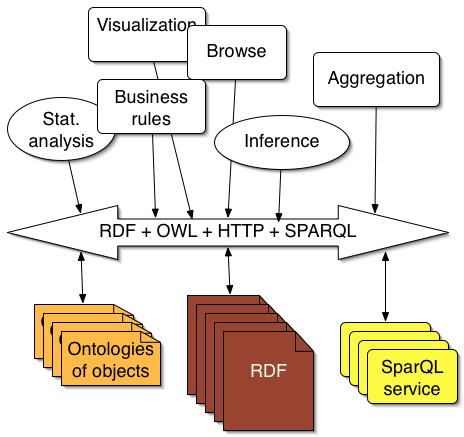As the
Linked Data meme continues on it's quest to unravel the mysteries of the
Semantic Web vision, it's quite gratifying to see that
data virtualization comprehension: creating "Conceptual Views" into logically organized "Disparate & Heterogeneous
Data Sources" via "
Context Lenses" is taking shape, as illustrated in the "
note-to-self" post by
David Provost.
Virtualization of heterogeneous data sources is only achievable if you have a dexterous data model based "Bus" into which the data sources are plugged. RDF has offered such a model for a long time.

When heterogeneous data sources are plugged into an RDF based integration bus e.g., customer records sourced from a variety of tables, across a plethora of databases, you can only end up with true value if the emergent entities from such an effort are coherently linked and (de)referencable; which is what
Linked Data's fundamental preoccupation with dereferencable URIs is all about. Of course, Even when you have all of the above in place, you also need to be able to construct "
Context Lenses" i.e.,
context driven views of the
Linked Data Mesh (or
Linked Data Spaces).
Additional Diagrams:
1.
Clients of the RDF Bus 2.
RDF Bus Server plugins: Scripts that emit RDF
3.
RDF Bus Servers: RDF Data Managers (Triple or Quad Stores)
4.
RDF Bus Servers: Relational to RDF Mappers (RDF Views, Semantic Covers etc.)
5.
RDF Bus Server plugins: XML to RDF Mappers
6.
RDF Bus Server plugins: GRDDL based XSLT stylesheets that emit RDF
7.
RDF Bus Server plugins: Intelligent RDF Middleware